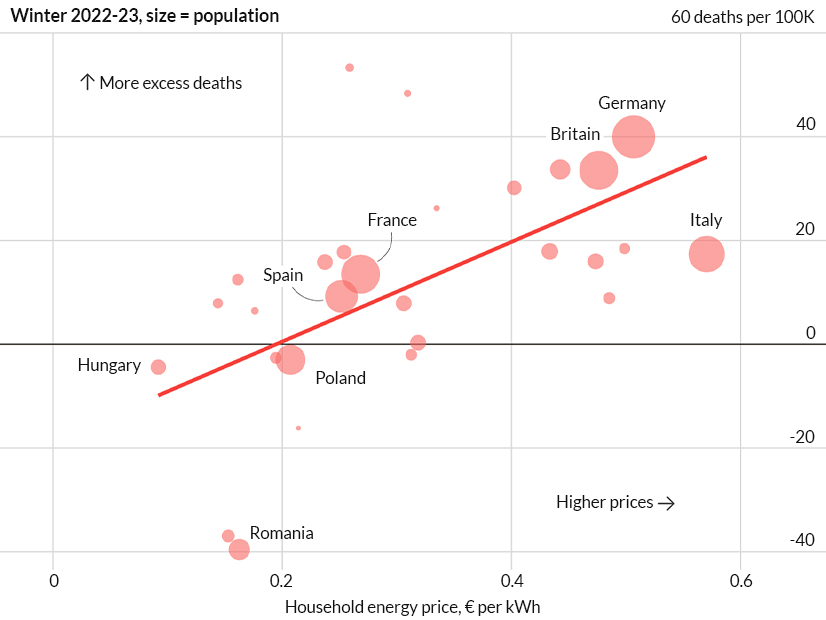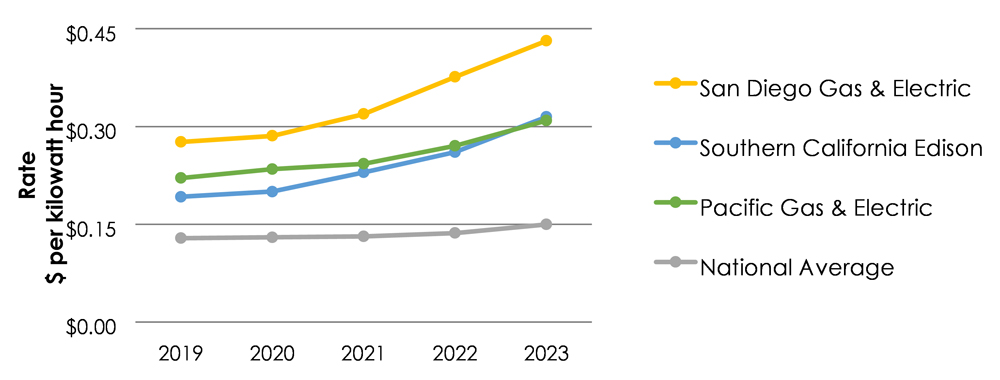It’s high time we consider how many deaths would result from higher residential energy prices due to the energy transition. The Economist points out: “High energy prices can cost lives. They discourage people from heating their homes properly, and living in cold conditions raises the risk of cardiac and respiratory problems.”[1]
The Economist analyzed “excess deaths” in Europe last winter that are attributable to the enormous increase in residential energy prices after Russian President Vladimir Putin weaponized natural gas supply. Its chart shows the correlation between higher energy prices and higher excess deaths.
Based on these data and other inputs, The Economist estimated that higher residential energy prices resulted in 68,000 excess deaths last winter in Europe — more excess deaths than COVID during that period.
US Study
Disturbed by The Economist’s analysis, I went looking for similar research in the U.S. One study came out earlier this year from three economists with this conclusion: “Our estimates imply that the 42% drop in the natural gas price [13% decline in household energy bills] in the late 2000s, mostly driven by the shale gas boom, averted 12,500 deaths per year in the U.S. The effect appears to be especially large in high-poverty communities.”[2]
Deaths can occur from reducing or forgoing food or medicine to pay for energy (25% of U.S. households reporting this form of energy insecurity) and/or living at an unhealthy temperature to save money (12% of U.S. households reporting this form of energy insecurity).[3]
Implications for the Energy Transition
What are the implications for the U.S. energy transition? California is a harbinger for the rest of the country. Its residential electric rates have increased way above the national average,[4] due in large part to its energy transition policies:[5]
These electric rate increases are just the beginning given California’s zero-carbon mandate for 2045.[6] Not to mention California’s phase-out of natural gas use that will impose sky-high electric rates for all space heating.[7]
As for the bigger picture, McKinsey says net-zero globally will require $3.5 trillion (that’s with a “t”) in new spending on low-emission assets per year to 2050.[8]
What We Don’t Know
How many lives are being lost with rising electric rates like these? We don’t know. And that’s a problem.
We need to figure out how much energy transition policies would increase electric rates, and how many deaths would result from such rate increases.
That — along with myriad other public policy considerations — needs to be factored into public policy decisions, such as what higher rates are justified, and who should pay them.[9]
A Closing Caveat
Let me acknowledge that there are other public health aspects of the electric industry, not the least of which are climate change and air pollution. Let me pass on the former other than to observe the obvious: “It’s complicated.”[10] About the latter a recent estimate put the range of premature deaths from electric generation air pollution at 4,000 to 9,000 per year;[11] presumably that number will continue to decline as natural gas and renewables continue to displace coal. It would seem from data discussed at the outset that excess deaths from the high rates necessary to end carbon emissions would be many times the lives saved from ending electric generation air pollution. But who knows? And that’s a problem.
Columnist Steve Huntoon, principal of Energy Counsel LLP, and a former president of the Energy Bar Association, has been practicing energy law for more than 30 years.
[1] https://www.economist.com/graphic-detail/2023/05/10/expensive-energy-may-have-killed-more-europeans-than-covid-19-last-winter
[2] https://gceps.princeton.edu/wp-content/uploads/2023/03/wp305_Jayachandran-et-al_heating_mortality_23jan.pdf
[3] https://www.eia.gov/consumption/residential/data/2020/hc/pdf/HC%2011.1.pdf. Smaller percentages suffer from inability to use heating or AC equipment due to monetary issues.
[4] https://www.publicadvocates.cpuc.ca.gov/-/media/cal-advocates-website/files/reports/230224-public-advocates-office-2022-electric-rates-report.pdf.
[5] One California utility says: “Currently, about 40% of what SDG&E customers pay in their bills go toward climate-related expenses.” https://www.sdge.com/rates/rates-whats-being-done-make-bills-more-affordable. One such policy is California’s net metering rules for rooftop solar, which hurt lower income households. https://energyathaas.wordpress.com/2021/06/01/rooftop-solar-inequity/ and https://energyathaas.wordpress.com/2022/06/05/myths-that-solar-owners-tell-themselves/. The net metering rules are being changed prospectively, but the damage will continue.
[6] My take on California’s scary no-carb future is here, https://www.energy-counsel.com/docs/No-Carb-California.pdf. Other reality checks are here, https://haas.berkeley.edu/wp-content/uploads/WP332.pdf, and here, https://www.economist.com/leaders/2022/11/03/the-world-is-missing-its-lofty-climate-targets-time-for-some-realism.
[7] All sales of residential gas heating units will be eliminated by 2035. https://ww2.arb.ca.gov/sites/default/files/2022-11/2022-sp.pdf, page 214.
[8] https://www.mckinsey.com/capabilities/sustainability/our-insights/the-net-zero-transition-what-it-would-cost-what-it-could-bring
[9] Or, dare I repeat myself, Plan B: solar geoengineering. https://energy-counsel.com/wp-content/uploads/2022/05/We-are-Going-to-Need-a-Plan-B-RTO-Insider-5-10-22.pdf. As Captain James T. Kirk said: “We all have to take a chance – especially if one is all you have.” https://www.imdb.com/title/tt0708484/characters/nm0000638.
[10] One discussion of complications is here, https://www.washingtonpost.com/climate-environment/interactive/2023/hot-cold-extreme-temperature-deaths/.
[11] https://iopscience.iop.org/article/10.1088/1748-9326/ac6cfa




